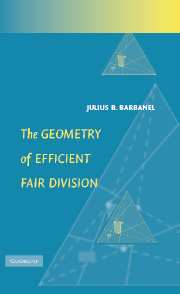Book contents
- Frontmatter
- Contents
- Introduction by Alan D. Taylor
- 1 Notation and Preliminaries
- 2 Geometric Object #1a: The Individual Pieces Set (IPS) for Two Players
- 3 What the IPS Tells Us About Fairness and Efficiency in the Two-Player Context
- 4 The Individual Pieces Set (IPS) and the Full Individual Pieces Set (FIPS) for the General n-Player Context
- 5 What the IPS and the FIPS Tell Us About Fairness and Efficiency in the General n-Player Context
- 6 Characterizing Pareto Optimality: Introduction and Preliminary Ideas
- 7 Characterizing Pareto Optimality I: The IPS and Optimization of Convex Combinations of Measures
- 8 Characterizing Pareto Optimality II: Partition Ratios
- 9 Geometric Object #2: The Radon–Nikodym Set (RNS)
- 10 Characterizing Pareto Optimality III: The RNS, Weller's Construction, and w-Association
- 11 The Shape of the IPS
- 12 The Relationship Between the IPS and the RNS
- 13 Other Issues Involving Weller's Construction, Partition Ratios, and Pareto Optimality
- 14 Strong Pareto Optimality
- 15 Characterizing Pareto Optimality Using Hyperreal Numbers
- 16 Geometric Object #1d: The Multicake Individual Pieces Set (MIPS) Symmetry Restored
- References
- Index
- Symbol and Abbreviations Index
6 - Characterizing Pareto Optimality: Introduction and Preliminary Ideas
Published online by Cambridge University Press: 19 August 2009
- Frontmatter
- Contents
- Introduction by Alan D. Taylor
- 1 Notation and Preliminaries
- 2 Geometric Object #1a: The Individual Pieces Set (IPS) for Two Players
- 3 What the IPS Tells Us About Fairness and Efficiency in the Two-Player Context
- 4 The Individual Pieces Set (IPS) and the Full Individual Pieces Set (FIPS) for the General n-Player Context
- 5 What the IPS and the FIPS Tell Us About Fairness and Efficiency in the General n-Player Context
- 6 Characterizing Pareto Optimality: Introduction and Preliminary Ideas
- 7 Characterizing Pareto Optimality I: The IPS and Optimization of Convex Combinations of Measures
- 8 Characterizing Pareto Optimality II: Partition Ratios
- 9 Geometric Object #2: The Radon–Nikodym Set (RNS)
- 10 Characterizing Pareto Optimality III: The RNS, Weller's Construction, and w-Association
- 11 The Shape of the IPS
- 12 The Relationship Between the IPS and the RNS
- 13 Other Issues Involving Weller's Construction, Partition Ratios, and Pareto Optimality
- 14 Strong Pareto Optimality
- 15 Characterizing Pareto Optimality Using Hyperreal Numbers
- 16 Geometric Object #1d: The Multicake Individual Pieces Set (MIPS) Symmetry Restored
- References
- Index
- Symbol and Abbreviations Index
Summary
We now turn our attention to characterizations of Pareto optimality. Suppose that P is a partition. How can we determine whether or not P is Pareto maximal or Pareto minimal? We have seen that P is Pareto maximal if and only if m(P) is on the outer Pareto boundary of the IPS and that P is Pareto minimal if and only if m(P) is on the inner Pareto boundary of the IPS. However, the relevant IPS is not always available to us. Our goal is to find other ways to make this determination. We begin by considering Pareto maximality.
Of course, if P is not Pareto maximal, the presentation of a Pareto bigger partition establishes this. But it may not, in general, be clear how to find such a Pareto bigger partition and, of course, our inability to find such a Pareto bigger partition is not a proof that there is none. The methods presented in Examples 6.3 (where we show that a certain partition is not Pareto maximal) and 6.6 (where we show that a certain partition is Pareto maximal) are rather ad hoc. We wish to develop general characterizations for Pareto maximality (and, of course, Pareto minimality too).
Chapters 7, 8, and 10 each focus on a different approach.
- Type
- Chapter
- Information
- The Geometry of Efficient Fair Division , pp. 151 - 159Publisher: Cambridge University PressPrint publication year: 2005



